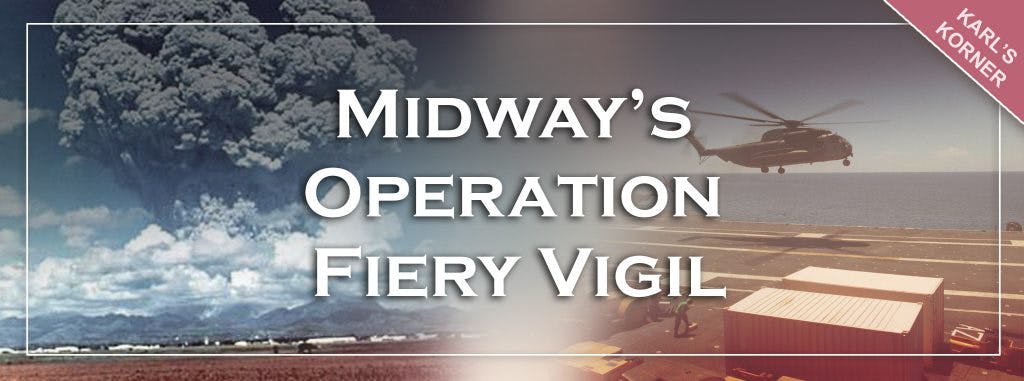 February 25, 2019 | Karl’s Korner
February 25, 2019 | Karl’s KornerMidway’s Operation Fiery Vigil
Hello and welcome to “Karl’s Korner”, a historical segment written by myself, Karl Zingheim – Ship Historian of the USS Midway Museum! This month we wanted to take a look back into Midway History, revisiting the historic Operation Fiery Vigil rescue mission.
Setting the Scene
Just two months returned from combat operations in Desert Storm on 16 June 1991, the USS Midway’s Supply Officer, Commander Jim Reily, had plenty of issues to address, including a shrinking staff now that the Navy decided to decommission the ship ahead of schedule, and a set of orders to a new duty station. It was time to move on. But, nature had other priorities. Some 1850 miles to the south, the Mount Pinatubo volcano on Luzon awoke from a five-century slumber just days before, and on the 15th, an explosion shot ash and debris 100,000 feet into the sky. Coincidentally, a typhoon raged in the region, and the rain and ash fall produced a cataclysm in central Luzon that smothered evacuated towns and villages, and swept away roadbeds. Two major U. S. military installations, Clark Air Force Base, and Naval Station Subic Bay, were drenched in ash. Approximately 20,000 Air Force and Navy dependents, as well as civilian employees, needed to leave immediately.
1800 Unexpected Guests Aboard Midway
An evacuation task force was swiftly assembled, including the nuclear carrier Abraham Lincoln, the amphibious assault ship Peleliu, and the Midway. Fortunately for Jim Reily, although the Midway was in port, everyone lived aboard the Naval Base at Yokosuka, so he could find the rest of his department quickly. Much like the preparations for the fall of Saigon more than sixteen years earlier, the air wing would stay ashore to make room for evacuees as well as the helicopter flights to transfer them. Thousands of cots were shipped in from the Army depot at Camp Zama outside Tokyo. Since the Midway housed an all-male crew, feminine, infant, and pet needs had to be addressed, so Jim sent his purchasers to the Navy Exchange with open purchase vouchers, essentially blank checks, to find the goods. After a day and a half of effort, the supplies were loaded and the ship set out for the distressed Philippines. Just off Okinawa, huge Marine Corps CH-53 Sea Stallion helicopters from HMH-772 landed aboard. As the Midway continued southward, the Hangar Deck transformed as the forward bay took on rows of bare Army cots, while the aft bay saw rows of tables brought up from the Mess Decks. Cookout gear normally used for Steel Beach picnics arose nearby to form “Ernst’s Eatery,” named after Captain Larry Ernst, who assumed command just three days prior. The Ship’s Store on the Second Deck made room for the feminine and baby supplies. Ironically, in an anticipation of the preparations needed to make the Midway Museum family-friendly a dozen years later, wire mesh was applied to all the deck edge railings to keep little ones from falling into the drink. Rows of televisions lined either side of the Hangar, and trips to the heads would be escorted below decks. When the ships arrived at Subic Bay on the 21st, most of the evacuees had been transferred out by Air Force transports, but some 5,000 still remained. The base no longer resembled a tropical paradise, as pale ash coated everything in sight, collapsing roof tops, and shredding foliage from the trees. Inland, cars were half mired in the muck, abandoned where they stalled on the roads. Soon, the evacuees arrived and were processed rapidly aboard the ships. In addition to their belongings, the Midway’s 1,823 volcano refugees carried aboard 23 cats, 68 dogs, and one gecko. Now facing a miniature Noah’s ark, Jim and his crew prevailed upon a less-than enthused Aircraft Maintenance Officer to take over his Jet Shop near the fantail and install makeshift kennels as well as coat his deck with straw, thus converting the “Jet Shop into a Pet Shop.” The stressed evacuees soon made themselves feel at home, enjoying 24-hour food service featuring steaks, hamburgers, and hot dogs, and their first showers in over a week. After the people and animals trooped aboard, the Midway and her cohorts cast off for a high-speed trip south to Cebu in the central Philippines. From there the evacuees would be flown from Mactan airport to Guam. However, the logistics had not quite caught up with the flow of events, and early reports came back that there was no water or food to be had at the airport. Rear Admiral Dan March went ashore to help straighten matters out, while Jim and his crew brought up bottled water and C-rations. Chaplain Paul W. Murphy held a truncated special mass in the forward end of the Hangar Deck as the helicopter transfers began. One of the Midway’s SH-2 Sea Kings made a forced landing on the beach just short of the airport, but everyone stepped off unharmed. Later that the day, the Marines hefted the bird back aboard with one of their Sea Stallion helicopters. By day’s end, the evacuation was completed, and the Midway returned to Japan to begin her transition out of active service, while Jim Reily and the rest of the crew prepared for their next duty stations, thus ending another chapter in the Midway’s legendary career. As always, thank you for reading, Midway Family! Please leave me a comment below and tell me what you thought of this month’s Karl’s Korner. Did you know about this unique evacuation in Midway's history?
Launch em’… until next time,
Karl
Your Adventure Starts Now
Your email is the key to information that will open up all your possibilities for exploring the mighty Midway!

